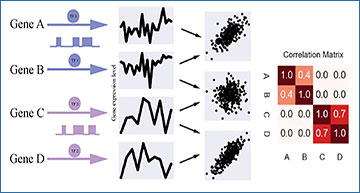Correlations in gene expression are used to infer functional and regulatory relationships between genes. However, correlations are often calculated across different cell types or perturbations, causing genes with unrelated functions to be correlated. Researchers at Harvard University and Peking University demonstrate that correlated modules can be better captured by measuring correlations of steady-state gene expression fluctuations in single cells. The researchers have developed a high-precision single-cell RNA-seq method called MALBAC-DT to measure the correlation between any pair of genes in a homogenous cell population. Using this method, they were able to identify numerous cell-type specific and functionally enriched correlated gene modules. They confirmed through knockdown that a module enriched for p53 signaling predicted p53 regulatory targets more accurately than a consensus of ChIP-seq studies and that steady-state correlations were predictive of transcriptome-wide response patterns to perturbations. This approach provides a powerful way to advance our functional understanding of the genome.
(A) A schematic model depicting how gene regulatory interactions can result in correlations in a steady-state population. Genes A and B are coregulated by TF1, while genes C and D are coregulated by TF2. Stochastic fluctuations in a transcription factor will result in fluctuations in its target genes, causing them to be correlated. Independently regulated genes, on the other hand, will exhibit no correlation. (B) Measurement error associated with estimating correlation from a limited number of cells. Plotted are the distributions of correlations that would be measured for a pair of uncorrelated genes if a given number of cells were sampled. (C) Impact of detection efficiency on correlation measurements. For a pair of genes with a given true correlation, the correlation that would be measured by sampling an unlimited number of cells is plotted as a function of the detection efficiency for individual transcripts. (D) MALBAC-DT protocol and experimental workflow. A homogenous cell population is trypsinized and sorted into individual wells of 96-well plates by flow cytometry. Reverse transcription is carried out using a poly-T primer containing a cell-specific barcode and unique molecular identifier (UMI). First-strand cDNA is amplified by random primers using MALBAC thermocycling to ensure linear amplification followed by additional cycles of exponential amplification by PCR. After amplification, samples are pooled together for library preparation and sequencing.
Chapman AR, Lee DF, Cai W, Ma W, Li X, Sun W, Xie XS. (2022) Correlated gene modules uncovered by high-precision single-cell transcriptomics. PNAS 119(51):e2206938119. [article]





